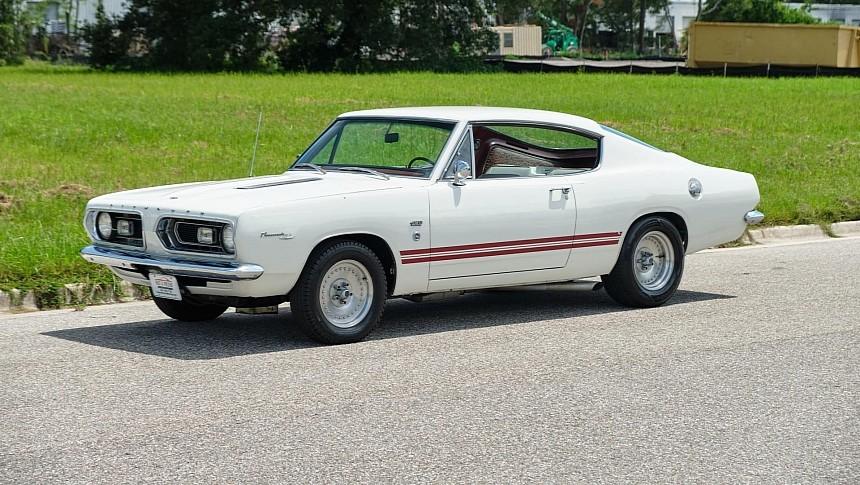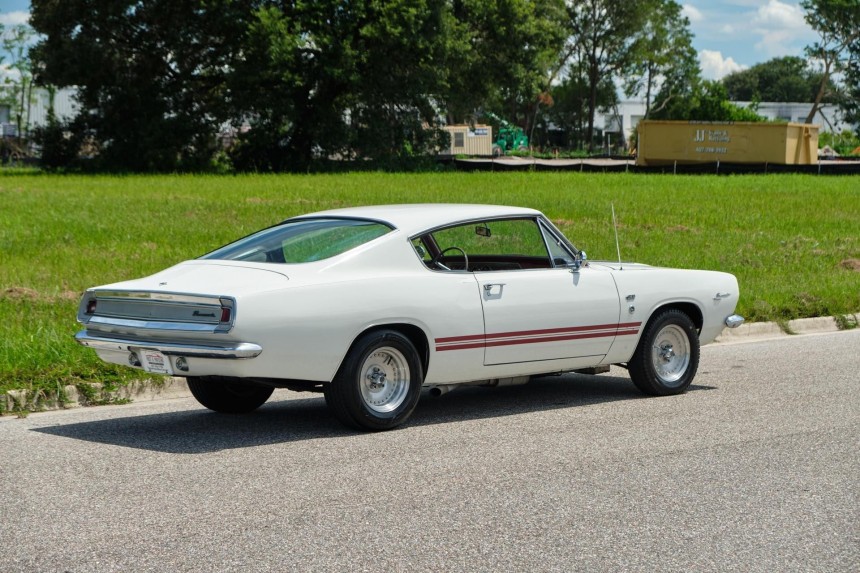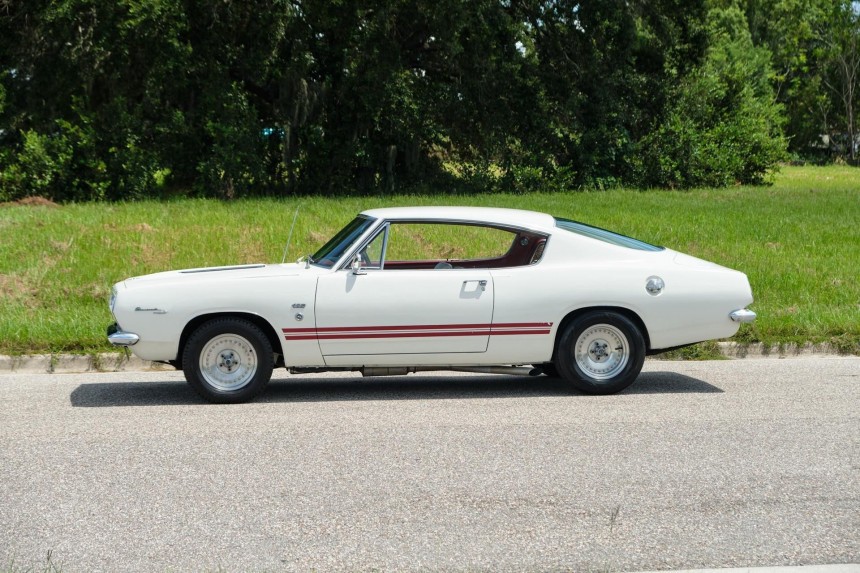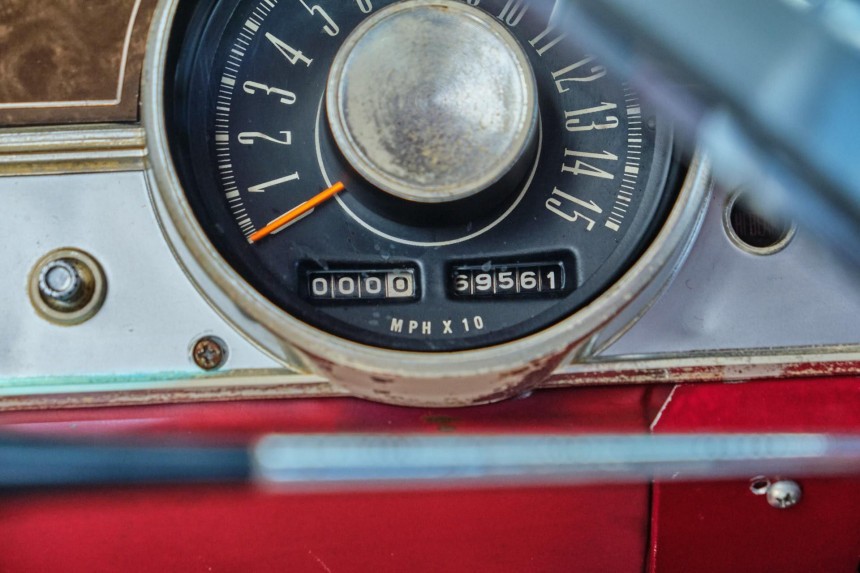Between 1964 and 1967, the pony car market was shared among two rivals placed at the opposite end of the sales spectrum: the Plymouth Barracuda, the car that started the trend, and the two-week-late-to-the-party Ford Mustang that completely stole the show.
For three years, the duo would be the only two pony cars on the market, with Ford being the quasi-unanimous buying decision of the American public. However, in 1967, competition arrived: GM pitted the Camaro and the Firebird against the galloping stallion, and even Ford decided it would be a good idea to upscale its sales-sweetheart design under the Mercury Cougar badge.
Plymouth restyled the Barracuda, introduced the notchback and convertible bodies to the lineup, and reaped the rewards. Sales increased to 62,500 in 1967 from 54,500 in 1966, but the car was seriously underpowered.
That year, Plymouth’s main gun for the restyled pony was a four-barrel 383 cubic-inch (6.3-liter) V8, but its 280-hp output was vastly overwhelmed by Ford’s 315-hp 390-cube V8 (6.4-liter). As with the rest of the competition, it was a downright unconditional capitulation: the Chevrolet Camaro was undisputed at 375 hp from the 396 CID V8 (6.5-liter). Even the Pontiac Firebird was looking down at the Barracuda from its 325-hp 6.6-liter V8.
Chrysler did have the hypothetical option of shutting everyone up with the roaring big-blocks, like the 426 Street HEMI and the mighty 440. There was a small problem, however: the Barracuda engine bay. It couldn’t fit the massive powerplants, which led Plymouth to redesign the Barracuda from the ground up for the model’s third (and final) generation in 1970.
Because of this lack of vital space, the Barracuda 383 V8 made significantly less power than what was delivered in the Belvedere and Fury. 325 hp would have been a serious contender in the pony car arms race. Also, because of this mismatch between the engine and the car, the Barracuda couldn't offer power steering or air conditioning with the big-block 383.
But the second-gen cars could only watch as the horsepower wars brought the fight to Chrysler, and Ma Mopar had nothing to counter with. Sure, the refreshments made in the looks department were more than welcome. Gone was the gigantic wrap-around rear window (the biggest installed on a series-production automobile until then) of the first generation, and the fastback wasn’t the only choice buyers could make anymore.
The fastback model was the best-seller, with 30,110 assembled, with a base price of $2,639. One of those was born with the standard 273 cubic-inch V8 (4.5-liter) but decided to avenge all its past kins and is now armed with a 426 HEMI.
It’s not completely clear where the car got its current engine from, but the 180-hp two-barrel 273 V8 is gone. The mileage - 69,561/112,000 km - could very well be the original one. However, the ad on eBay doesn’t say anything about this aspect.
The HEMI runs – hear it in the attached video – and the restoration work was undertaken with the goal of transforming the 1967 Barracuda into a Formula S tribute (see the badges on the front fenders). 426 HEMI emblems adorn the fenders, which can be both revealing and misleading at the same time. The iconic big-block was not paired with the street-going ‘Cudas until 1970, although the racing versions had achieved significant performance with it.
Nonetheless, this tribute car is a deserved nod to the inceptor of the pony segment – although it is undeservingly left out of the conversation when this automotive event is brought up. The Barracuda out-paced the Mustang on its market launch. Still, a fish car sounds a lot less desirable than a pony car, so Plymouth had to admit defeat.
However, this Mother of All Barracudas screams ‘pay-back time’ out of its dual- four-barrels, and the 425 hp and 490 lb-ft (431 PS/664 Nm) can strain the fragile A-body seriously. How exactly the engine swap happened is another mystery, and it comes with a $56,967 price – way above the high bid of $15,100 (one of three offers for this one-of-one 1967 Plymouth Barracuda). The three-speed automatic transmission has a console-mounted shifter between the white vinyl front bucket seats.
The seller noted the black vinyl dashpad to be in like-new condition, with no cracks or fading (see more details in the gallery). The driver-side mirror is remotely adjustable (manually). The car sits on a heavy-duty suspension and drives on Center Line Mag wheels with wide-oval tires.
Plymouth restyled the Barracuda, introduced the notchback and convertible bodies to the lineup, and reaped the rewards. Sales increased to 62,500 in 1967 from 54,500 in 1966, but the car was seriously underpowered.
That year, Plymouth’s main gun for the restyled pony was a four-barrel 383 cubic-inch (6.3-liter) V8, but its 280-hp output was vastly overwhelmed by Ford’s 315-hp 390-cube V8 (6.4-liter). As with the rest of the competition, it was a downright unconditional capitulation: the Chevrolet Camaro was undisputed at 375 hp from the 396 CID V8 (6.5-liter). Even the Pontiac Firebird was looking down at the Barracuda from its 325-hp 6.6-liter V8.
Because of this lack of vital space, the Barracuda 383 V8 made significantly less power than what was delivered in the Belvedere and Fury. 325 hp would have been a serious contender in the pony car arms race. Also, because of this mismatch between the engine and the car, the Barracuda couldn't offer power steering or air conditioning with the big-block 383.
But the second-gen cars could only watch as the horsepower wars brought the fight to Chrysler, and Ma Mopar had nothing to counter with. Sure, the refreshments made in the looks department were more than welcome. Gone was the gigantic wrap-around rear window (the biggest installed on a series-production automobile until then) of the first generation, and the fastback wasn’t the only choice buyers could make anymore.
It’s not completely clear where the car got its current engine from, but the 180-hp two-barrel 273 V8 is gone. The mileage - 69,561/112,000 km - could very well be the original one. However, the ad on eBay doesn’t say anything about this aspect.
The HEMI runs – hear it in the attached video – and the restoration work was undertaken with the goal of transforming the 1967 Barracuda into a Formula S tribute (see the badges on the front fenders). 426 HEMI emblems adorn the fenders, which can be both revealing and misleading at the same time. The iconic big-block was not paired with the street-going ‘Cudas until 1970, although the racing versions had achieved significant performance with it.
However, this Mother of All Barracudas screams ‘pay-back time’ out of its dual- four-barrels, and the 425 hp and 490 lb-ft (431 PS/664 Nm) can strain the fragile A-body seriously. How exactly the engine swap happened is another mystery, and it comes with a $56,967 price – way above the high bid of $15,100 (one of three offers for this one-of-one 1967 Plymouth Barracuda). The three-speed automatic transmission has a console-mounted shifter between the white vinyl front bucket seats.
The seller noted the black vinyl dashpad to be in like-new condition, with no cracks or fading (see more details in the gallery). The driver-side mirror is remotely adjustable (manually). The car sits on a heavy-duty suspension and drives on Center Line Mag wheels with wide-oval tires.

















